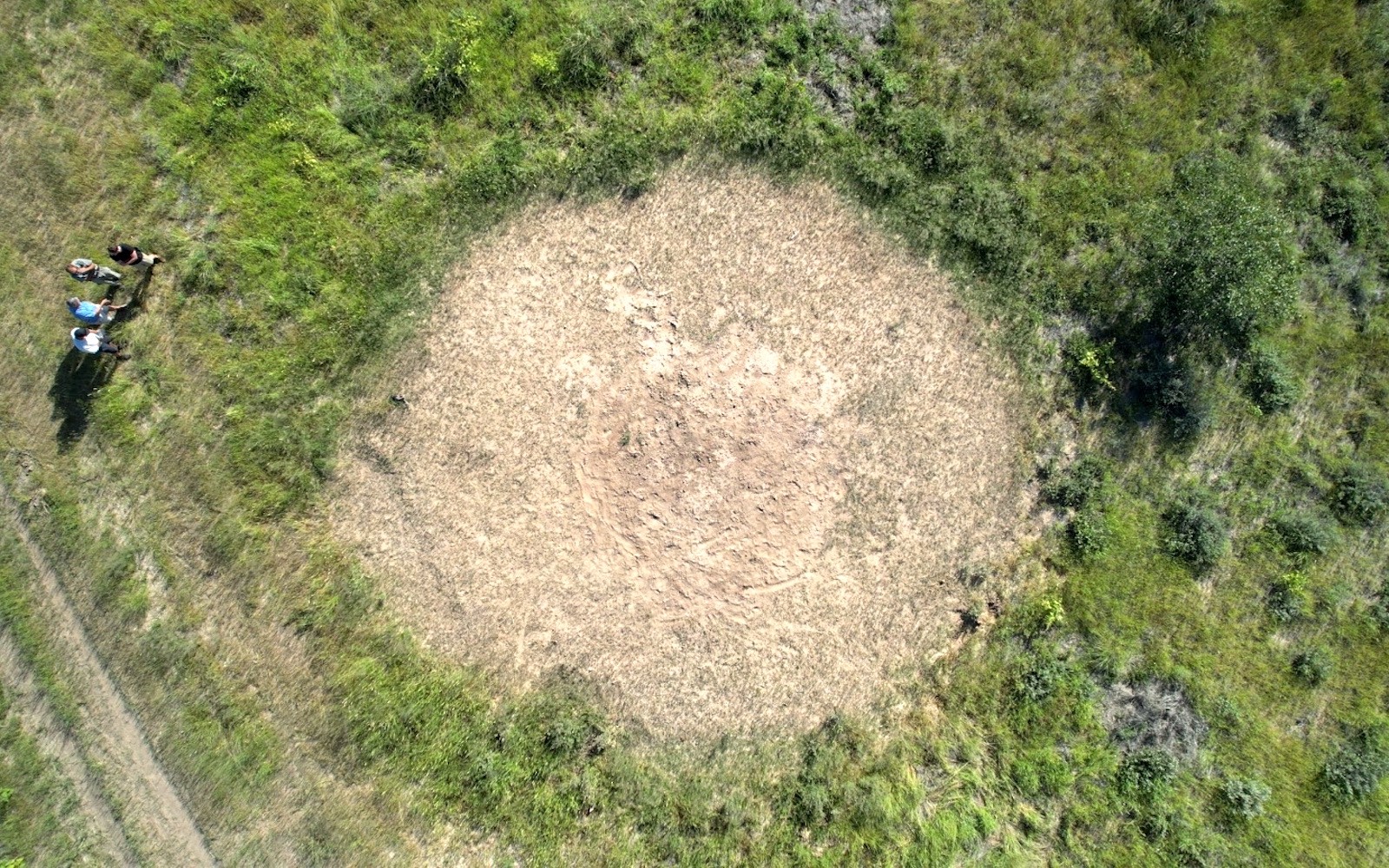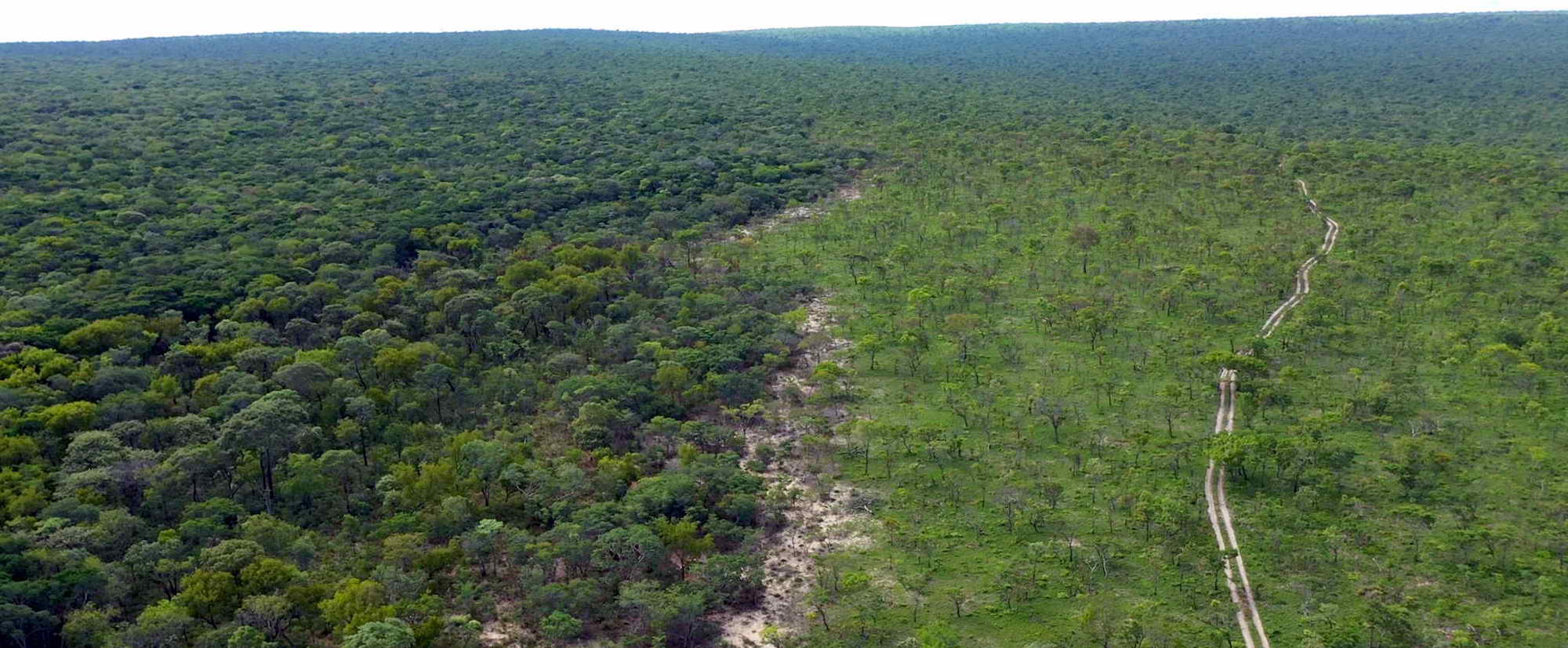
About fairies of all sizes
14th November 2022
Science and art are two sides of the same creative coin. Both employ curiosity, are inspired by the enigmatic, intrigued by the unknown, and often in awe of the beautiful. The most extreme enigmas are surely the work of fairies, or so we imagine. Why fairies? Because none of us have seen them, and so we can only be fascinated by the sorts of things that fairies might make, or what they can do.
Neat circles in vegetation are particularly bizarre and attractive, so much so that the hundreds of thousands of bare round shapes in the Namib Desert are said to be fairy circles. They are also the battleground of scientists who argue over explanations for their structure and origins: are they formed by foraging termites, poisons left by euphorbias, or strange ways in which plants are spaced because of competition for water and nutrients, for example?
We have found two other communities of fairies. They are the subject of this article, and they, too, are round. We use the more awkward term fairy spheres for one form to avoid being embroiled in the contests that surround the Namib's fairy circles, and the circular limits imposed on the term. Our fairy spheres are also bare areas, many of which are almost perfect circles. But they are in bushy areas in central northern Namibia, which are quite different from the Namib desert's sparse grass cover.

The others are fairy forests in miombo woodlands growing in sandy soils in Angola and probably elsewhere. What follows comes from our pleasure in trying to find the fairies responsible for their spheres and forests. It is our hope that more creative minds build on these observations to convert these mysteries into better understood marvels of the natural world.
Fairy spheres – of termites and grasses
Active termite mounds provide ideal growing conditions for many plants, likely a consequence of termites bringing moist and fertile soil to the surface as part of their mound-building activities. But as the mounds age, broaden and decline in height, fringes of bare soil develop and seem to steadily spread outwards around the mounds in many areas. Once dead, the mounds slump and are further flattened by large herbivores (e.g. gemsbok and zebra) trampling the surrounds and rubbing themselves on the mounds.
Consequently, areas of bare soil increase over time and around dead termite mounds. Bear in mind that the soil spread out around and from the mounds originally came from some depth below the surface. The largest fairy sphere we have found is about 35 metres in diameter, but most are between 15 and 25 metres in diameter.


A distinctive feature of the spheres in certain areas are the sharp margins between the bare areas and surrounding vegetation. Within less than 50 centimetres of the margins, the grass cover and species composition changes abruptly. The spheres with sharp margins seem to be limited to clayey soils on relatively flat ground.
In the Ongava Game Reserve, short, probably nutritious grass species predominate inside the circles after good rains have fallen, while the grasses outside form a denser, taller cover of vegetation that is largely avoided by grazers. Given the many game paths connecting these spheres, it seems clear that these short grasses attract zebra, springbok, white rhino and impala. Once grazed, the circles remain bare until good rains fall again in the next year or following years. In these respects, our fairy spheres function like so-called grazing lawns that are more extensive in wetter parts of Africa.
However, something else is most peculiar. Broad-leafed and woody plants are absent from the bare spheres, despite the surrounding area often being densely vegetated with these plants, and despite their likely previous vigorous growth immediately around tall, younger, occupied mounds. Many of the trees and shrubs growing in areas near the spheres are obviously old and mature, having grown there for many decades.
A good number of spheres at Ongava have become permanently vegetated again with tall grasses, mostly by species that are not particularly favoured by herbivores. The change from bare areas to grassy spheres probably happens over quite a few years. And we imagine that woody plants will then return even later, perhaps after many more decades.
Our observations have sparked many simple questions that invite further investigation, such as: What removes the vegetation from the bare areas in the first place? Why do many of the spheres have such sharp edges? Why do they occur in certain areas and not others? How old are the spheres? What causes their initial revegetation by grasses but not by woody plants? How long does revegetation take?


We think that some of the answers to these questions are also simple. For instance, the properties of soils brought up by termites from underground may inhibit the growth of certain plants; the termites eat away the roots of plants growing in the spheres; or the termites change the chemistry or structure of the soil in ways that retard plant growth. Perhaps the soils create nutrient hotspots offering high quality forage that herbivores remove and trample, leaving the spheres bare; or certain grasses grow so rapidly in these richer soils that they exhaust supplies of nutrients for slower growing perennial plants.
Each answer seemingly has merit, but fails at some stage to hold water, or at least enough water. Perhaps two or more processes are at work, some possibly important during the early stages of termite mound development, others perhaps operating later as the mounds die off.

Investigating fairy spheres may seem to be esoteric or unimportant. Not so. These spheres are numerous, and in certain areas they may make grazing temporarily available to lots of animals. We estimate that 20% of the vegetated area of Etosha National Park has these spheres. Taking an average radius of 7.5 metres per sphere and a conservative density of 100 spheres per square kilometre suggests that at times there could be over 6,000 hectares of nutritious grazing in over 330,000 spheres in Etosha.
These are estimates, but surely tantalising enough to seek answers on the origins, functioning and effects of these spheres. Perhaps the processes at work will provide clues about measures to limit bush growth and control its encroachment in Namibia? And, who knows, studies of these spheres may even shed light on the enigmatic activities of fairies in the Namib? Indeed, we surmise that those fairy circles could also be bare areas that persist after termite colonies have died, as Ken Tinley suggested in 1971[1].
Fairy forests – an Angolan enigma
We first came across these remarkable features in Google Earth, a free service of high-resolution satellite images that has led to many discoveries all over the world. Two things stood out in the images of south-eastern Angola: many patches of forest were circular in form, and they and other areas of forest with smoothly rounded edges had distinctive white margins. The smaller the forest patches, the more circular they are. More fairies at work?
Fieldwork in south-eastern Angola led to several observations and tentative findings. Both the rounded forests and the white margins are associated with miombo forests on sandy soils in Angola (the dominant trees in these forests are Julbenardia paniculata, Brachystegia spiciformis and Brachystegia longifolia and Cryptosepalum exfoliatum). The white areas are sparsely vegetated with little grass, and they are white because so much of the pale underlying soil is visible from above.
Two big questions: why do the patches of forest have rounded edges, and what could form their bare margins? We believe that the answers lie in the hot fires that burn here so often, indeed almost every year. The fires are largely concentrated in two habitats: grasslands on wet soils in floodplains and drainage lines, and in open woodlands that are scattered in and around the miombo forests. The open woodlands are savannah-like, their relatively abundant grass cover providing fuel for fires. By contrast, the dense miombo forests seldom burn because there is little fuel to burn on the forest floors.
We suggest that the rounded edges and circular forests are due to fires killing trees and bushes growing on the margins of the dense woodland, rather like ocean waves smoothing the shores of sandy coastlines. With repeated fires, any outlying trees susceptible to burning are shaved away, leaving the forests with well-defined, rounded edges.
But there may be a second reason why the miombo forests don't burn: the bare, white margins act as firebreaks. Most are 20 to 40 metres wide, and with little grass or other fuel they are good at keeping away scorching flames from the forest edges. Fires can do great damage if they get into these forests, which does happen occasionally when flames are so fanned by strong winds that they roar through the forest canopy, killing most trees in their paths.

This leads us to the intriguing possibility that miombo trees protect themselves by forming firebreaks. What, however, could suppress the growth of grass around the forests? One plausible hypothesis is that forest trees produce chemicals that are specifically poisonous to grasses and other plants that burn easily. These are known as allelopathic chemicals, which certain plants produce to protect themselves against other plants. Thus, allelopathic chemicals produced by miombo trees might diffuse out of the forests to poison the surrounding margins, and their diffusion may be aided by the sandy soils in these areas of south-eastern Angola.
Which of the miombo trees might produce these allelopathic effects? A good candidate is Brachystegia bakeriana, which was found to be the dominant miombo tree on the margins of the forests. However, other miombo species may also inhibit plant growth as suggested by the presence of small bare patches within forests, and the sparse growth of plants often found in the margins of fields cleared inside forests.
Interestingly, these rounded forests and white margins are not seen further south in the so-called Baikiaea-Burkea woodlands that are also burnt very often and that also grow on deep Kalahari sand. Brachystegia trees do not grow in these woodlands in southern Angola and northern Namibia.

One last observation comes from Howard Hunter who found miombo woodlands with rounded edges and bare margins in Niassa province in northern Mozambique. Have a look at this area in Google Earth (11.8414 South 35.6975 East). And the soils there? Sandy!
Here ends this collection of curiosity, observations, and speculations. We hope our ideas are reasonably informed, but now they need to be tested, refined, or replaced with better explanations and hypotheses. We also hope that energetic young scientists are challenged by these ideas. From their investigations much that is good will be found in Africa's bushlands and forests.
1Tinley, K.L., 1971. Etosha and the Kaokoveld. African Wild Life (Supplement) 25, 1–16.
[This reference is not currently available online, but is nonetheless considered to be a valuable source of additional information.]
Acknowledgments
We pestered many experts on enigmas and fairies, among them Mike Bingham, William Bond, Tony Cunningham, Helge Denker, Frank Eckhardt, Rina Grant, Wayne Hansen, Chris Hines, Howard Hunter, Brian Huntley, Eugene Moll, Andy Moore, Ken Tinley, Cornelis van der Waal, and the late Marty McFarlane and Bob Scholes. For logistical support we thank Ongava Research Centre and the National Geographic Okavango Wilderness Project. Stefan Redecker and Steve Spence captured wonderful images with their drones. We are grateful to everyone for their enthusiasm and patience.
If you enjoyed this page, then you might also like:



For articles on similar topics, please click one of the following options:
For more great articles from Conservation Namibia see below...
Conservation Namibia brought to you by:
We use cookies to monitor site usage and to help improve it. See our Privacy Policy for details. By continuing to use the site, you acknowledge acceptance of our policy.








